[UPDATE] Luna-27 will receive a PILOT and PROSPECT
The Luna-27 automatic interplanetary station (the Luna-Resource-1 heavy landing gear) should be moored near the South Pole of the Moon in 2020 (the deadlines for missions had previously shifted) where to drill to a depth of 2 meters and study samples of the lunar regolith and ice in place.
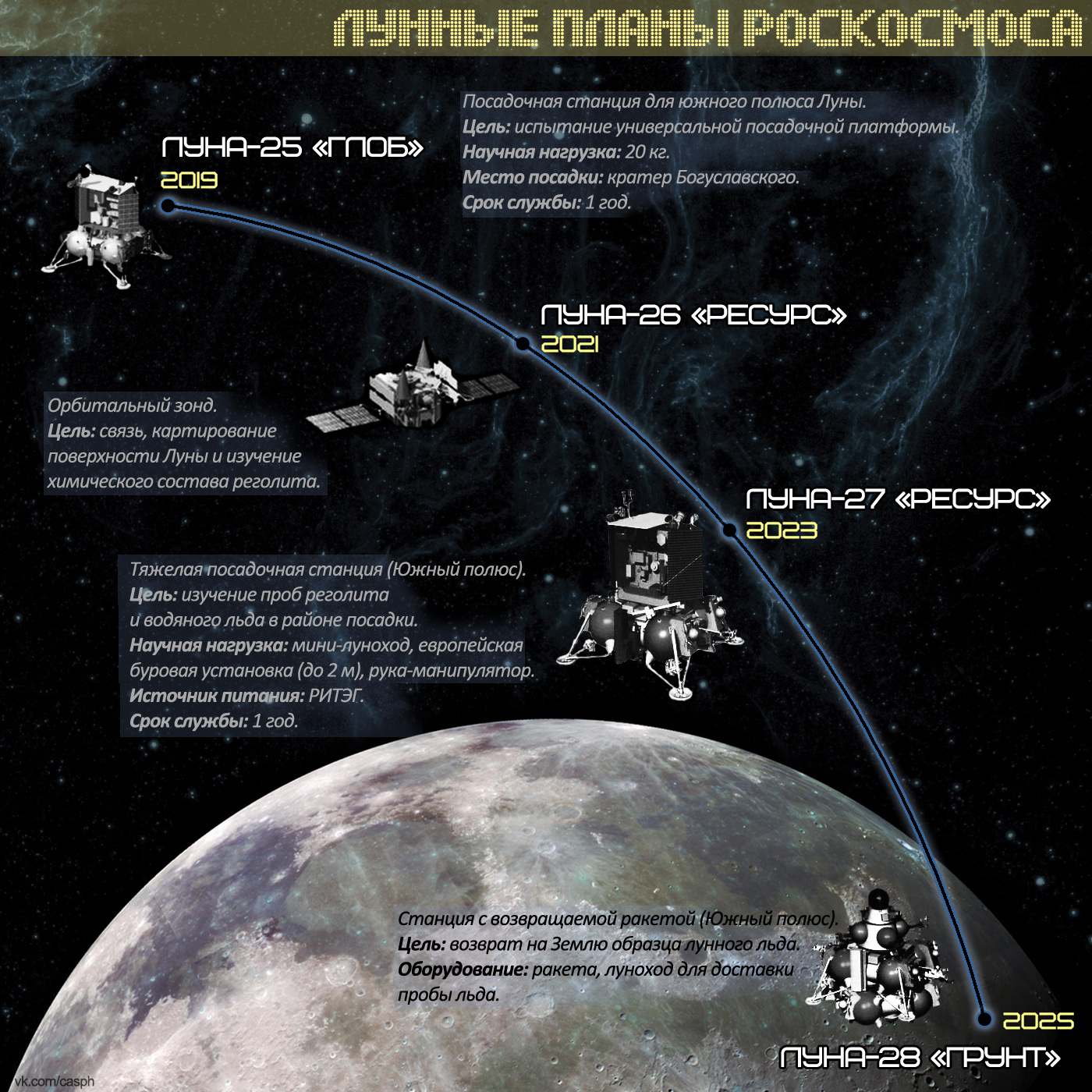
The exploration of the Moon has a high priority in the Federal Space Program, which includes a series of robotic missions over the next 10 years: an orbiter, landing gears and the delivery of lunar soil to Earth from the polar region of the Moon. Research plans provide for the sequential complication of missions, step by step from simple to complex. The first mission - Luna-25 (Luna-Glob) is a demonstration test, the purpose of which is to fly to the Moon and land on its surface. The scientific load is minimal, the device will serve the development of systems for remote space communications, control and landing. Success will demonstrate the ability of Roscosmos to land on the moon and preparedness for more complex research missions.
The Luna-Resource-1 station will be equipped with a PROSPECT drilling rig (PERSPECTIVE) from the European Space Agency (ESA), which has extensive experience in the development of drilling rigs for the Rosetta / Philae, Beagle 2 and Exomars missions.

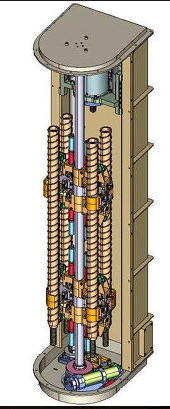
It was the discussion of the ExoMars mission that led to the decision to combine the experience of Roskosmos and ESA so that the Luna-Resource mission would become joint. For its part, ESA will provide an accurate and soft landing system “PILOT” and “PROSPECT”, a complex system for drilling regolith and exploring extracted images on site. The rover "ExoMars", which is scheduled to land on the red planet in 2018, will be equipped with a structurally close drilling rig. Those. in fact, the Luna Resource drilling rig will be tested on Mars.
The development of the Prospecting for Exploration, Commercial exploitation and Transportation (PROSPECT) for Luna-27 will begin in 2015 (the document was published on the ESA website in December 2014) and must comply with Russian requirements for work on the circumpolar surface. Moons:
PROSPECT consists of two main parts - a drilling rig (PROSPECT Samples Excavation and Extraction Device: ProSEED) and a chemical laboratory (PROSPECT Sample Processing and Analysis system: ProSPA).
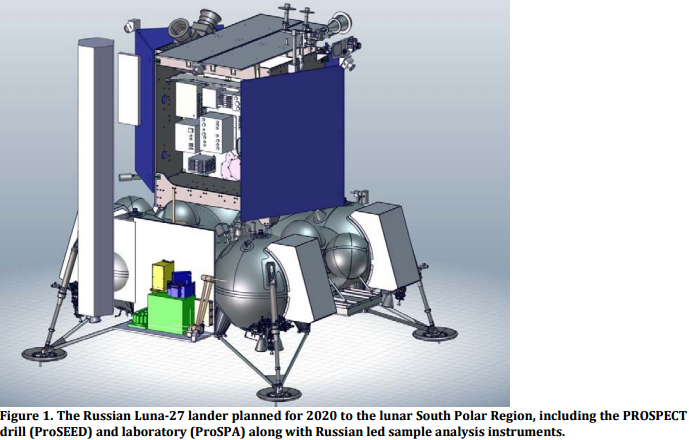
PROSPECT draws on the ESA experience gained through the development of apparatus for the Rosetta / Philae missions, Beagle 2 and Exomars in the field of drilling, sampling, processing and analysis of samples. In the lunar polar regions, PROSPECT will be able to explore water ice, if it is present at the landing site, and chemicals that may be contained in this ice. On the moon, PROSPECT will be able to extract volatiles from the regolith by heating. Among which are physically adsorbed, chemisorbed and introduced by the solar wind substances. There will also be extraction of oxygen from minerals.
Zelenyikot published a photo in the article What Russia will fly to the moon , which prompted to extract an article from the Drafts which I didn’t like without a photo.
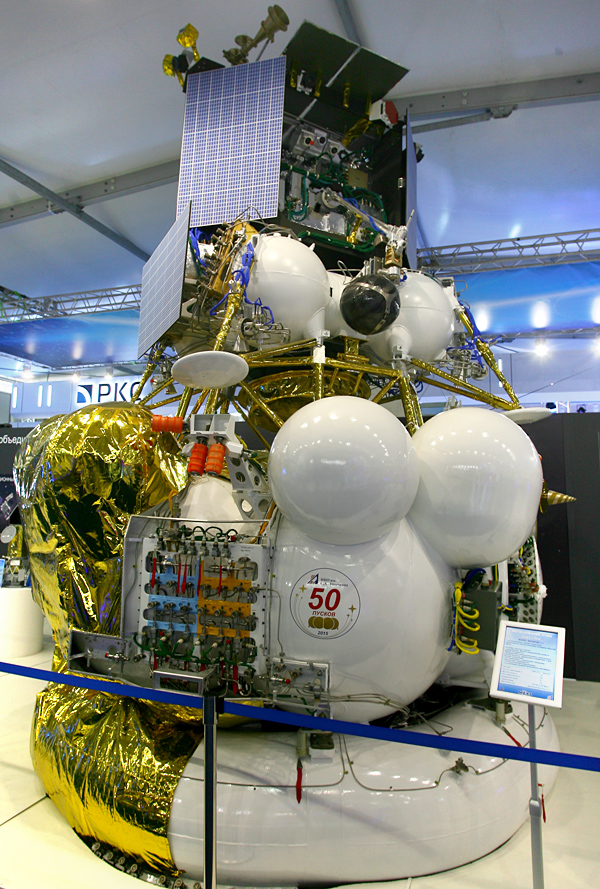
The landing gear with a manipulator is the "Luna-27". Only now without a lunar rover and with a gas balloon in its place. Most likely the layout was worked out on the layout, and there will be more changes in the flight apparatus.
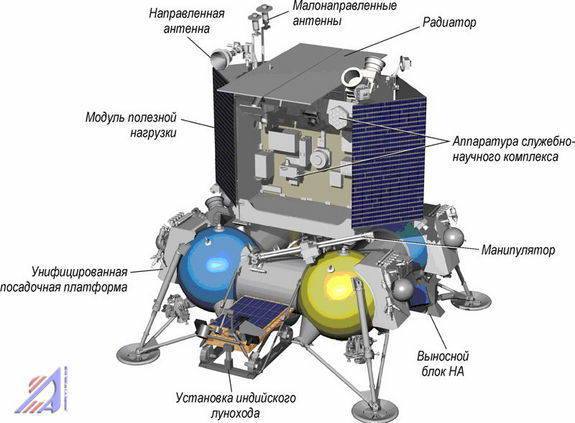

')
PROSPECT with a drill penetrates to a depth of 2 meters. Having reached the required depth, the instrument takes small samples of the regolith that contain volatile substances. The sample must be removed and processed with minimal changes and contamination, including the loss of volatile substances due to the heating of the drill during operation. Then the samples come to the furnace, where they are sealed.
Thermochemical processes of extracting substances from samples occur at temperatures of ~ 1000 ° C. Heating the sample in a vacuum removes ice, physically adsorbed, chemisorbed, and substances introduced by the solar wind. Gases can be introduced to the furnace to extract additional chemicals of interest to be studied. Methods for extracting substances include burning in oxygen, oxidation using fluorine and reduction using hydrogen or methane.
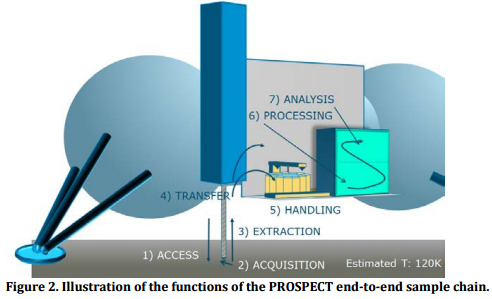
The chemical composition and the amount of released gases is estimated by the combination of the measured gas pressure and the results of mass spectroscopy.
The isotopic composition of the emitted gases is determined by a specialized mass spectrometer. The released substances require preparation before they are examined by a specialized mass spectrometer — the analytes are thermally separated using their different absorption capacities and transformed into those chemical compounds that are most optimal for analysis in a magnetic sector mass analyzer.

The isotopes are separated by a magnetic sector mass analyzer and the measurements made are compared with the standards - this method has high accuracy, allowing a direct comparison with the laboratory measurements on the Earth of images of meteorites and lunar soil.
It is necessary to develop a set of equipment for controlling these processes: drilling and sampling, measurement of the characteristics of samples, which may include taking photographs, infrared spectroscopy, temperature and electrical permeability.
Everything voiced is still being developed and may change. Planetologists expect to find at the landing site certain chemicals of scientific and practical interest. Chemists are developing methods for the isolation and analysis of these substances. Engineers are developing a hardware and software complex of scientific tools.
The soil research relay will be picked up (someday) by Luna-28, which delivers soil samples from the polar regions of the moon to earth laboratories.
The South Pole is an unknown area of the moon in terms of surface conditions and a potentially resource-rich region. The study will help address fundamental scientific issues related to the Moon, the history of the origin of substances of the young Earth and the origin of life, will allow to explore the lunar resources and explore their potential use for future missions of unmanned and manned cosmonautics. The possibility of extracting water, oxygen, and useful mineral resources will attract and increase public and scientific interest in research and exploration of the moon. And ultimately advance humanity to the creation of lunar bases.
UPDATE: Added a video about the Luna-25 mission and scientific interests at the lunar poles

The exploration of the Moon has a high priority in the Federal Space Program, which includes a series of robotic missions over the next 10 years: an orbiter, landing gears and the delivery of lunar soil to Earth from the polar region of the Moon. Research plans provide for the sequential complication of missions, step by step from simple to complex. The first mission - Luna-25 (Luna-Glob) is a demonstration test, the purpose of which is to fly to the Moon and land on its surface. The scientific load is minimal, the device will serve the development of systems for remote space communications, control and landing. Success will demonstrate the ability of Roscosmos to land on the moon and preparedness for more complex research missions.
The Luna-Resource-1 station will be equipped with a PROSPECT drilling rig (PERSPECTIVE) from the European Space Agency (ESA), which has extensive experience in the development of drilling rigs for the Rosetta / Philae, Beagle 2 and Exomars missions.

It was the discussion of the ExoMars mission that led to the decision to combine the experience of Roskosmos and ESA so that the Luna-Resource mission would become joint. For its part, ESA will provide an accurate and soft landing system “PILOT” and “PROSPECT”, a complex system for drilling regolith and exploring extracted images on site. The rover "ExoMars", which is scheduled to land on the red planet in 2018, will be equipped with a structurally close drilling rig. Those. in fact, the Luna Resource drilling rig will be tested on Mars.
The development of the Prospecting for Exploration, Commercial exploitation and Transportation (PROSPECT) for Luna-27 will begin in 2015 (the document was published on the ESA website in December 2014) and must comply with Russian requirements for work on the circumpolar surface. Moons:
- drilling to a depth of 2 meters and taking a sample
- extraction of water, oxygen and other chemicals of research interest
- chemical composition determination and quantification
- determination of isotopic composition, and its origin
PROSPECT consists of two main parts - a drilling rig (PROSPECT Samples Excavation and Extraction Device: ProSEED) and a chemical laboratory (PROSPECT Sample Processing and Analysis system: ProSPA).
PROSPECT draws on the ESA experience gained through the development of apparatus for the Rosetta / Philae missions, Beagle 2 and Exomars in the field of drilling, sampling, processing and analysis of samples. In the lunar polar regions, PROSPECT will be able to explore water ice, if it is present at the landing site, and chemicals that may be contained in this ice. On the moon, PROSPECT will be able to extract volatiles from the regolith by heating. Among which are physically adsorbed, chemisorbed and introduced by the solar wind substances. There will also be extraction of oxygen from minerals.
Zelenyikot published a photo in the article What Russia will fly to the moon , which prompted to extract an article from the Drafts which I didn’t like without a photo.

They even made a lug, although I thought that they would do without a manipulator, but the mockup on display was equipped with a bucket.
The landing gear with a manipulator is the "Luna-27". Only now without a lunar rover and with a gas balloon in its place. Most likely the layout was worked out on the layout, and there will be more changes in the flight apparatus.

')
PROSPECT with a drill penetrates to a depth of 2 meters. Having reached the required depth, the instrument takes small samples of the regolith that contain volatile substances. The sample must be removed and processed with minimal changes and contamination, including the loss of volatile substances due to the heating of the drill during operation. Then the samples come to the furnace, where they are sealed.
Thermochemical processes of extracting substances from samples occur at temperatures of ~ 1000 ° C. Heating the sample in a vacuum removes ice, physically adsorbed, chemisorbed, and substances introduced by the solar wind. Gases can be introduced to the furnace to extract additional chemicals of interest to be studied. Methods for extracting substances include burning in oxygen, oxidation using fluorine and reduction using hydrogen or methane.
The chemical composition and the amount of released gases is estimated by the combination of the measured gas pressure and the results of mass spectroscopy.
The isotopic composition of the emitted gases is determined by a specialized mass spectrometer. The released substances require preparation before they are examined by a specialized mass spectrometer — the analytes are thermally separated using their different absorption capacities and transformed into those chemical compounds that are most optimal for analysis in a magnetic sector mass analyzer.
The isotopes are separated by a magnetic sector mass analyzer and the measurements made are compared with the standards - this method has high accuracy, allowing a direct comparison with the laboratory measurements on the Earth of images of meteorites and lunar soil.
It is necessary to develop a set of equipment for controlling these processes: drilling and sampling, measurement of the characteristics of samples, which may include taking photographs, infrared spectroscopy, temperature and electrical permeability.
Everything voiced is still being developed and may change. Planetologists expect to find at the landing site certain chemicals of scientific and practical interest. Chemists are developing methods for the isolation and analysis of these substances. Engineers are developing a hardware and software complex of scientific tools.
The soil research relay will be picked up (someday) by Luna-28, which delivers soil samples from the polar regions of the moon to earth laboratories.
The South Pole is an unknown area of the moon in terms of surface conditions and a potentially resource-rich region. The study will help address fundamental scientific issues related to the Moon, the history of the origin of substances of the young Earth and the origin of life, will allow to explore the lunar resources and explore their potential use for future missions of unmanned and manned cosmonautics. The possibility of extracting water, oxygen, and useful mineral resources will attract and increase public and scientific interest in research and exploration of the moon. And ultimately advance humanity to the creation of lunar bases.
UPDATE: Added a video about the Luna-25 mission and scientific interests at the lunar poles
Source: https://habr.com/ru/post/365601/
All Articles